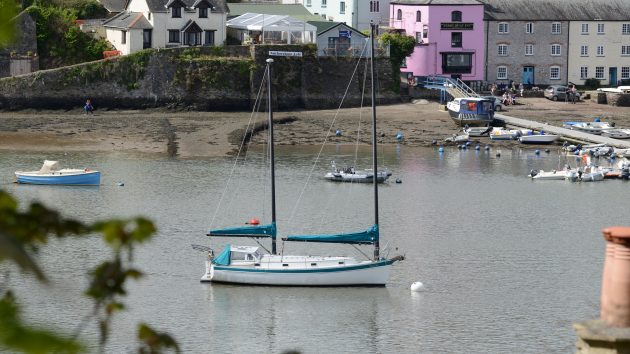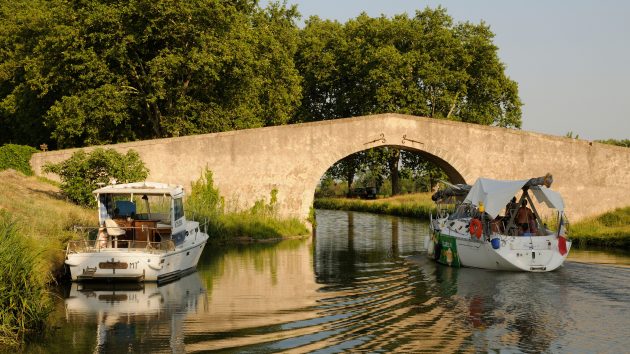When Nic Compton decided to take his family and their boat to the Mediterranean ‘as the crow flies’, he embarked on a steep learning curve to get boat and crew ready
Let’s go to the Med!’ my wife and I decided one fine day. And canal cruising in France onboard our yacht sounded so easy.
After all, we had sailed down to the West Country several times in the 12 months since we bought Zelda, our Freedom 33, and felt we had got the measure of the boat.
Sailing to France and on to the Med would be the same, just a bit longer, surely?
But of course preparing a boat to sail 70 miles from your home port is completely different to a 700-mile voyage ranging from the Atlantic coast to the inland waterways.
At times just getting to the start line has felt like a full-time job, alongside a real full-time job and family life.

An Ovni 395 passes through a lock. Depths in the canals can vary, so shallow draught or a lift keel will help. Credit: Graham Walker
At least we had the right boat for the project.
When we bought our 1982 Freedom 33, one of the considerations was that we might want to head off to the Med in stages, and therefore we needed a boat that could be left unattended.
We had narrowly averted several charming-but-impractical wooden boats and ended up with a boat with vast accommodation for her length and minimal varnish on deck – both important factors in an affordable home-from-home that might end up being parked in some distant destination.
But then Brexit happened, followed by Covid. Suddenly, sailing to the Mediterranean seemed incredibly complicated and, for most of 2021, downright impossible.
As we emerged from those events, we looked carefully at the rules.

The carbon spars on Nic’s yacht were in good condition, but insurers were not used to dealing with unstayed rigs. Credit: Gideon Sherwood
One of the main ones affecting us was the requirement for boats to leave the EU every 18 months, or be liable to pay VAT.
We were pleased to read that you could extend the 18 months by up to six months by keeping the boat out of the water and handing over the ship’s papers to the local authority.
So at worst, that would mean making a trip to non-Schengen countries such as Albania, Croatia or Turkey every two years, which sounded just fine by me.
There was also the limit on staying in the Schengen zone only 90 days out of 180.
As our children were still at school and we had no desire to home-school them (been there, done that), we were only intending to use the boat for a few weeks at a time anyway.
So that didn’t really bother us either – yet.
Routes for canal cruising in France
And so I started looking at possible destinations, initially based around the idea of sailing to the South of France in the first year and on to Greece the following year.
I soon found facilities in both countries which offered a ‘dry sail’ option, where the boat is stored out of the water and launched when you want to use it.
A single ‘in and out’ was included in the price, and thereafter you paid a fixed haulage fee each time you used the boat.
At around €2,000 per year plus €240-270 for each extra ‘in and out’, this was considerably cheaper than a marina and even compared favourably to the price of a swinging mooring on the River Dart!

Routes for canal cruising in France. Credit: Maxine Heath
From the outset, my wife was excited by the idea of canal cruising in France – something she had wanted to do for years – so that was baked into the plan from the start.
We both liked the idea of going through the Canal du Midi, which would involve a short sea voyage for me and a couple of sailing friends down to Bordeaux followed by three weeks of leisurely canal cruising with the family.
Just a few weeks before the planned departure, however, we discovered that the canal is only guaranteed to be 1.4m deep at its centre, rather than the widely publicised figure of 1.5m.
Zelda was only 1.42m deep in salt water, but fresh water would add another 2.4%, which gave a fresh water draught of 1.45m.
Online forums on the topic varied wildly, from boats with 1.2m draught barely scraping through to others with 1.55m draughts getting through without any problem.
There were other reports of boats having to be craned out and put on a low-loader for the rest of the journey.
After much agonising, we decided it was too risky and opted for the deeper (but much longer) route via Rouen and Paris.
Costs and insurance
Financing the project was another issue.
As we calculated the costs, we realised we would be stretched beyond our means and almost gave up on the whole idea, until my two boating friends – who were by now at least as excited by the trip as we were – offered to split all the expenses of the trip three ways.
We were back on!
The final piece of the jigsaw was getting insurance – there was no way I was taking our precious carbon-fibre masts through the canal network without insurance.
Our existing boat insurance policy covered us to Bordeaux but no further.

While Nic’s boat was out of the water he switched antifouling to one suitable for the Mediterranean. Credit: Nic Compton
I managed to get that extended to ‘not more than 10 degrees east’ (up to just west of Italy) for a £56 additional premium and then ‘not east of 25 degrees east (nor south of 34 degrees north)’ (up to the middle of the Aegean) for an extra £84.34.
But there was a catch.
The underwriters wanted to know when the boat’s standing rigging had last been replaced.
When I told them there was no standing rigging, only two beautiful, free-standing carbon-fibre masts, they asked for a ‘professional inspection’ of the spars.
Getting a survey of a pair of 40-year-old carbon-fibre masts proved surprisingly difficult.
Continues below…
Sailing to France: what you need to know
If you are sailing to France, here is what you need to know to avoid immigration and customs headaches for…
Cruising after Brexit and sailing in Europe
As Europe begins to open up again for cruising, Lu Heikell looks at the implications of Brexit on UK sailors…
Sailing the French canals: lessons learned
From buying a suitable yacht to negotiating 371 locks, three tunnels and travelling 1,400 miles from Fareham, Lizzy Bolan shares…
Shakedown Sail in a Freedom 33
Searching for a new boat to replace our beloved Victoria 26 wasn’t easy, writes Nic Compton. During September 2020, after…
The local rigger was clearly out of his depth and dropped out, so we had to get a carbon-fibre expert from Plymouth – the legendary Stig McDonald, who has worked with Nigel Irens in the past and has built several carbon-fibre masts himself – to give them the thumbs up.
He declared them to be in ‘very good condition’.
Finally, in the middle of February 2022 – just three months before our planned departure date – we received the all-clear from the insurance company.
We were all set to go!
Boat preparations
I then entered into a period of many lists – and at least as many sleepless nights. I had lists of paper work, lists of purchases, lists of jobs.
I virtually had lists of lists, for goodness’ sake.
The job list covered all areas of the boat, from the domestic to the sea-going and some specific to the canals.
With Biscay in mind, we fitted new halyards and replaced all the lashings on the stanchions and the jacklines.
We reversed the sheets and spliced an eye at the working end to replace the crude knots that were there before.

Safety equipment: When choosing a liferaft, a valise was easier to stow, and more secure when not on board. Credit: Nic Compton
We also upped our safety equipment, buying a liferaft, EPIRB, a throw line, new flares, and new fire extinguishers.
The liferaft was the subject of great debate: whether to have a valise or a canister type, and where exactly to mount it.
Bearing in mind the ultimate aim was cruising in the Med rather than any great offshore passage, we eventually opted for a valise liferaft stowed in the large cockpit locker where the fenders and outboard used to live.
That way it was easy to access yet could easily be locked away when the boat wasn’t in use.
We then had to relocate the outboard, as there wasn’t room for both in the locker.
An outboard bracket on the aft rail was the obvious solution, though I was reluctant to fork out £50 for a ready-made one (and even less willing to pay £15 for a nasty plastic one).

Transport ashore: Three bikes were squeezed in to cycle beside the canal and get to shops easily. Credit: Nic Compton
Instead, I cut to length a chunky piece of driftwood I found in the river and attached it with three hefty U-bolts (total cost: £12.24 plus a few drops of blood when I cut myself while sawing off the bolts ends).
It won’t last forever but, with the help of a bit of varnish, it should last long enough.
The trip influenced our decisions on many levels, bringing some jobs forward that we might have delayed (the cutlass bearing which I might have put off replacing for another year but definitely needed doing for the amount of motoring we would be doing in the canals).
It even affected our choice of antifouling, as we switched from the Hempel Tiger Xtra which had been recommended for the West Country by various cruiser forums to the International Micron 350 suggested for Mediterranean waters.
Below decks, a shower was a prerequisite of spending several weeks on board, so we fitted a new Osculati mixer shower/tap (£87.95 from Force 4 Chandlery) and reinstated the shower drain.
For the canals, we bought a pair of folding bikes (£80 and £55 on eBay) so that Anna and the kids could take turns cycling on the towpath in between the locks.
We also bought extra fenders (£7 each from Marine Bazaar in Plymouth – why buy new when they would probably be wrecked and have to be thrown away by the end of the trip?).
And we planned to build a wooden crutch for the mast.
Mast transport
One of the big unknowns before we set off was how easy the masts would be to take down.
The plan was to dismast in Rouen, where there would hopefully be a crane operator with experience of lifting unstayed masts (and therefore lacking crosstrees).
Once down, the masts would sit between the pushpit and the wheelhouse, with wooden crutches forwards and in the middle.
With four weeks to go, I had yet to make the crutches but I had refined the design in my head during countless sleepless nights so that I felt confident I had arrived at the perfect solution.

ou’ll need to get the masts lifted, and then pay for transport, or carry them on deck. Credit: Lizzy Bolan
Time will tell whether I was right.
In any case, we knew the main mast was some 45ft long and would therefore overhang the boat by about 6ft at each end – not a prospect I was very much looking forward to.
We seriously considered having the masts transported, but the quote we received from Fastmast of €1,800 for both masts or €1,300 just for the main mast (ex storage) put paid to that idea.
Paperwork and qualifications for canal cruising in France
The thought of all the paperwork we needed also kept me awake at night.
For the boat, we needed an up-to-date Small Ships Registry certificate, a radio license to cover the VHF and EPIRB, proof of VAT payment on the boat, and a valid insurance policy.
But worst of all, I needed sailing qualifications.
Now, I’ve lived on boats since I was knee-high to a spider crab; I’ve owned six sailing boats of various sizes which I’ve sailed as far afield as Greece, Italy, France, Spain, Portugal and Ireland.
But I’ve never taken a sailing exam (other than RYA Powerboat Level 2).

After several months of preparation, Zelda was ready to slip her home mooring and sail for the Med. Credit: Nic Compton
So it was with some degree of trepidation that I approached the ICC (International Certificate of Competence) apparently required by EU.
I chose the cheapest and fastest option: a single-day test on my own boat, with an examiner supplied courtesy of SeaRegs in Plymouth (£285 inc VAT).
The revision (yes, I revised!) and the test itself were harder than I expected and definitely exposed some weak areas in my knowledge (sound signals!).
But, while it kept me on my toes, it was also a timely reality check just ahead of what would be a fairly serious voyage, and I felt much better prepared by the end of it.
The ICC was followed by the CEVNI, an inland waterways exam which you take online (cost £20).
There’s no official tuition but you can do the trial test as many times as you like and the same questions tend to come up again and again.
Alternatively, the RYA’s book European Waterways Regulations covers the exam topics very well.
The test itself is a strange mix of very specific inland waterways questions (fair enough) and general lights and signals which I can only imagine coming across while at sea.
I bought the book after I passed the test, so that Anna (and possibly the kids) could gen up on signage and the rules of the road for the canals.
The CEVNI was in turn followed by the VHF exam (£80 for the online course, courtesy of SeaRegs, and £60 for the RYA exam).
Having a radio certificate is another EU requirement, but it too proved invaluable for brushing up on my VHF radio etiquette.
Finally, the whole lot had to be certified by the RYA – which cost another £47 to join. And so, nearly £500 later, I was finally qualified to sail.
The whole process has proven more stressful and more expensive than I expected – at last count we had spent £4,000 before even leaving the UK.
A couple of times I’ve actually felt overwhelmed by the amount of organisation needed.
But the idea of sailing the French canals and being able to sail my own boat in the Med – after an absence of more than 30 years – has kept me going.
Gradually the hurdles have fallen by the wayside and, with only four weeks to go until we set sail, I’m finally allowing myself to think it might actually happen.
See you on the other side!
Route options: Paris or The Midi?
Paris-Nevers-Lyon-Marseille is 1,300km, with 184 locks. The max draught 1.8m.
Canal du Garonne & Midi is 645km, with 118 locks. The max draught 1.4m
Costs for canal cruising in France:
Miscellaneous equipment: £1,500
Safety equipment: £1,218
Engine repairs and checks: £435
Electronics repairs: £300
Qualifications: £492
Total: £3,945
Further reading
Through the French Canals, David Jefferson (Adlard Coles, £25)

Buy Through the French Canals from Amazon (UK)
Buy Through the French Canals from Amazon (US)
Buy Through the French Canals from F0yles (UK)
Buy Through the French Canals from Waterstones (UK)
European Waterways Regulations, Tam Murrell (RYA, £9.99)

Buy European Waterways Regulations at Amazon (UK)
Buy European Waterways Regulations at Amazon (US)
Buy European Waterways Regulations at Waterstones (UK)
Mediterranean France & Corsica Pilot, Rod & Lucinda Heikell (Imray, £45)

Buy Mediterranean France & Corsica Pilot from Amazon (UK)
Buy Mediterranean France & Corsica Pilot from Amazon (US)
Buy Mediterranean France & Corsica Pilot from Foyles (UK)
Buy Mediterranean France & Corsica Pilot from Waterstones (UK)
Fluviacarte Inland waterways charts (Fluviacarte, €20 each)

Buy Fluviacarte Inland waterways charts from the Fluviscarter website
Inland Waterways of France by David Edwards May (Imray, £21.50)

Buy Inland Waterways of France from Amazon (UK)
Buy Inland Waterways of France from Amazon (US)
Note: We may earn a commission when you buy through links on our site, at no extra cost to you. This doesn’t affect our editorial independence.
Visit the Yachting Monthly Book Club for more of the best sailing books released this year.
Enjoyed reading Canal cruising in France: how to prepare the boat & crew?
A subscription to Yachting Monthly magazine costs around 40% less than the cover price.
Print and digital editions are available through Magazines Direct – where you can also find the latest deals.
YM is packed with information to help you get the most from your time on the water.
-
-
- Take your seamanship to the next level with tips, advice and skills from our experts
- Impartial in-depth reviews of the latest yachts and equipment
- Cruising guides to help you reach those dream destinations
-
Follow us on Facebook, Twitter and Instagram.








